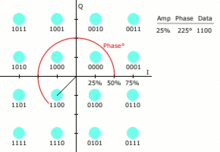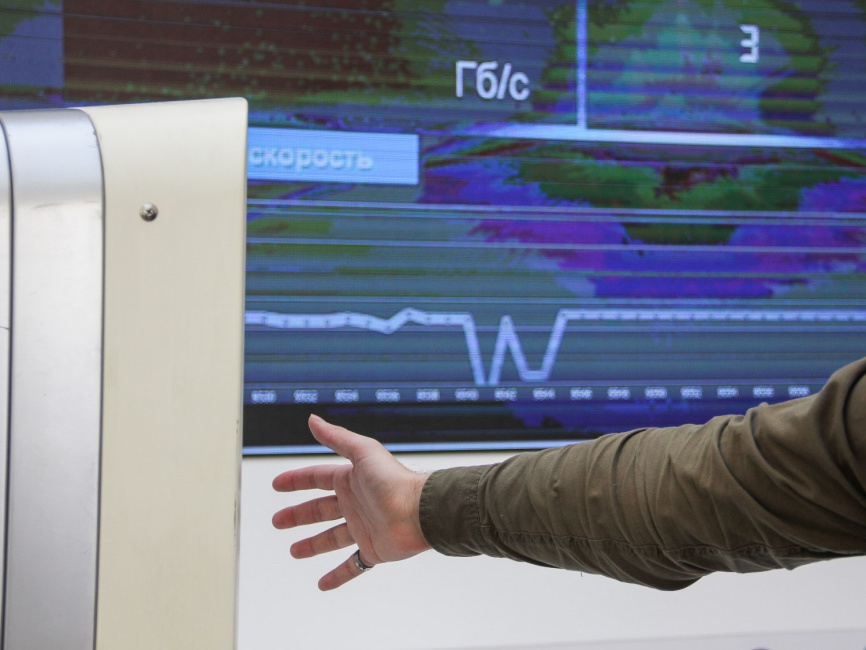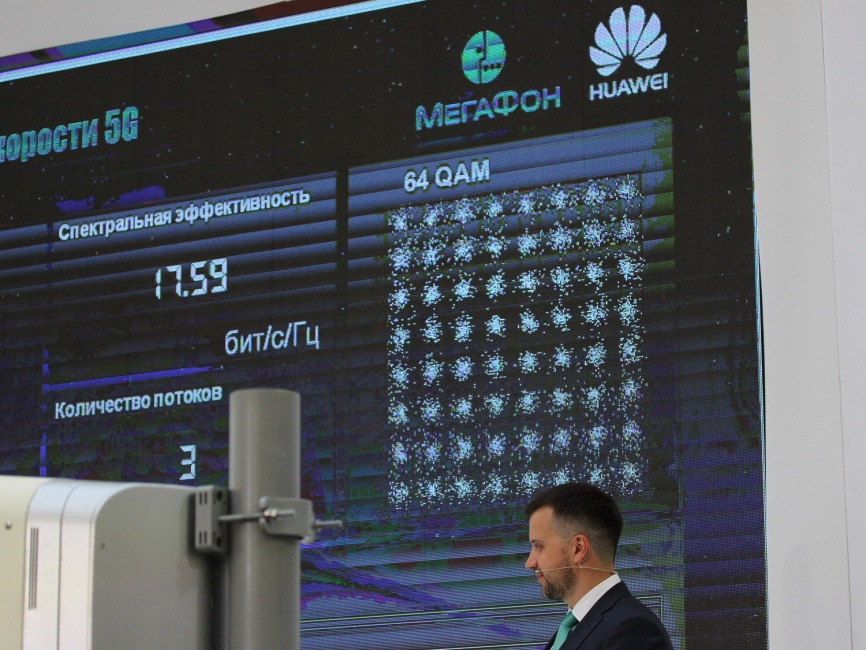35 Gb / s - how Megafon and Huawei set a 5G speed record
Operators and equipment manufacturers are confidently moving towards 5G, increasing and increasing speed. A year ago, it was 1 Gb / s, last September Megafon and Nokia demonstrated prototypes of BS and 5G devices with a maximum speed of 5 Gb / s, and on June 1 this year, at the St. Petersburg Economic Forum, Megafon and Huawei achieved a maximum speed of 35 Gb / sec, setting a record for the speed of mobile Internet. Already on the day of this event, news agencies circulated photos from the event and made noise about the speed achieved. And today we reveal interesting technical details of the record.

The introduction of the next generation of mobile communications is expected in 2020 (this is fully consistent with the assessment “a new technology of mobile communications every 10 years”). As you approach the "hour X" standard 5G takes on more and more obvious outlines. At the same time, operators and equipment manufacturers are experimenting with frequencies and communication channels, determining the direction of further movement. How successful these experiments are, show the data transfer rates demonstrated in the next tests.
About a year ago, MegaFon, together with Huawei, demonstrated a data transfer rate of 1 Gb / s. This result was obtained by transmitting data at several frequencies simultaneously (using three carriers), which, in turn, was made possible thanks to refarming - the use of frequencies that were originally intended for another technology.
Refarming is an inevitable phenomenon in the evolution of communication standards, since the frequency range has long been painted between consumers. From a technical point of view, refarming allows optimizing the use of the spectrum: with the development of technologies, it becomes possible to “push” much more data into the same frequency band (just compare GSM, 2G and subsequent standards). In some countries, refarming may be limited by legislative restrictions, since when allocating frequencies, not only its main user is recorded, but also the communication standard that will be used at this frequency. In Russia, for a number of ranges transferred for mobile communications, the principle of technological neutrality has already been adopted, which means that any generation of the communication standard can be used in the range.
In the framework of the mentioned experiment, Megafon and Huawei involved the frequency of 1800 MHz, which was previously used for GSM networks.

However, the experiments continue. The solution demonstrated this year at the St. Petersburg Economic Forum, instead of aggregating frequencies from different ranges, uses one, but very wide frequency band - 2 GHz - in the 70 GHz band to communicate the prototype of the base station and the subscriber terminal (this is one of the possible frequencies of the future 5G standard ) During testing, we managed to achieve a data transfer rate of 35 Gb / s, which is an absolute record for mobile data transfer.

Although at this stage it was a question of testing wireless communication between a stationary prototype of a base station and a conditionally stationary prototype of a subscriber device (it was installed at the Megafon stand and did not interfere anywhere), in the development process it is necessary to take into account the mobility of subscribers. For this, the fifth generation provides for bimforming - a dynamic change in the radiation pattern of a phased array antenna in the direction of the largest cluster of subscriber terminals. Megaphone in a nutshell spoke about the features of this technology.
If you don’t go into technical details, bimforming requires the creation of a complex antenna, but it can partially correct the situation “there is no communication in the crowd” - the base station will simply rebuild the radiation pattern in order to better cover the direction in which more devices are located.
In the experiment of Megaphone there was no crowd with subscriber devices, there was just one emitter and an irregularly shaped antenna that forms several beams - two parallel and one at an angle. Yes, the lilac plate with the company logo on the floor is not part of the design, it is a reflector for radio waves:

Nothing supernatural in it, it's just a plate of steel:

The transmission was carried out in TDD mode - two-way communication with the time separation of the receiver and transmitter signals.
As mentioned above, the new standards allow, other things being equal, to convey more information. Perhaps this is also due to the development of the computing power of mobile devices, which allows the use of more sophisticated modulation. In the experiment of Megaphone and Huawei, 64-QAM quadrature modulation was used.
Simplified QAM is a way to transfer several bytes of data in a single clock cycle. This is achieved, firstly, due to the fact that not only the signal level changes, but also its phase. And secondly, the amplitude and phase of the signal have several levels. The easiest way to show this is on such a GIF:

We see 16 states obtained by a combination of different phase shifts and signal amplitudes. All possible combinations of 4 bits can be put in them, so for one state of the signal we can transmit 4 bits at once.
The picture illustrates 16-QAM, but in 64-QAM everything is the same, there are simply more possible states - 64, which means we can transfer not 4, but 6 bits.
It is worth noting that the high carrier frequency, although it allows you to transfer a large amount of data, is very easily drowned out by any objects on the way.

It is enough to bring a hand to the emitter and the speed on the chart immediately drops. At the same time, we see how the signal constellation begins to crumble - an analog of eye diagrams for 64-QAM (well, strictly speaking, not only for it):

The signal constellation allows you to see the "quality" of the transmission and at the same time notice some problems (more details can be found here )
5G test zones MegaFon intends to deploy next year during the World Cup. By tradition, the new standards of mobile communications are tested during major international events.

We are approaching the 5G standard - aggregation and refarming
The introduction of the next generation of mobile communications is expected in 2020 (this is fully consistent with the assessment “a new technology of mobile communications every 10 years”). As you approach the "hour X" standard 5G takes on more and more obvious outlines. At the same time, operators and equipment manufacturers are experimenting with frequencies and communication channels, determining the direction of further movement. How successful these experiments are, show the data transfer rates demonstrated in the next tests.
About a year ago, MegaFon, together with Huawei, demonstrated a data transfer rate of 1 Gb / s. This result was obtained by transmitting data at several frequencies simultaneously (using three carriers), which, in turn, was made possible thanks to refarming - the use of frequencies that were originally intended for another technology.
Refarming is an inevitable phenomenon in the evolution of communication standards, since the frequency range has long been painted between consumers. From a technical point of view, refarming allows optimizing the use of the spectrum: with the development of technologies, it becomes possible to “push” much more data into the same frequency band (just compare GSM, 2G and subsequent standards). In some countries, refarming may be limited by legislative restrictions, since when allocating frequencies, not only its main user is recorded, but also the communication standard that will be used at this frequency. In Russia, for a number of ranges transferred for mobile communications, the principle of technological neutrality has already been adopted, which means that any generation of the communication standard can be used in the range.
In the framework of the mentioned experiment, Megafon and Huawei involved the frequency of 1800 MHz, which was previously used for GSM networks.

New Experiment - Beamforming
However, the experiments continue. The solution demonstrated this year at the St. Petersburg Economic Forum, instead of aggregating frequencies from different ranges, uses one, but very wide frequency band - 2 GHz - in the 70 GHz band to communicate the prototype of the base station and the subscriber terminal (this is one of the possible frequencies of the future 5G standard ) During testing, we managed to achieve a data transfer rate of 35 Gb / s, which is an absolute record for mobile data transfer.

Although at this stage it was a question of testing wireless communication between a stationary prototype of a base station and a conditionally stationary prototype of a subscriber device (it was installed at the Megafon stand and did not interfere anywhere), in the development process it is necessary to take into account the mobility of subscribers. For this, the fifth generation provides for bimforming - a dynamic change in the radiation pattern of a phased array antenna in the direction of the largest cluster of subscriber terminals. Megaphone in a nutshell spoke about the features of this technology.
If you don’t go into technical details, bimforming requires the creation of a complex antenna, but it can partially correct the situation “there is no communication in the crowd” - the base station will simply rebuild the radiation pattern in order to better cover the direction in which more devices are located.
In the experiment of Megaphone there was no crowd with subscriber devices, there was just one emitter and an irregularly shaped antenna that forms several beams - two parallel and one at an angle. Yes, the lilac plate with the company logo on the floor is not part of the design, it is a reflector for radio waves:

Nothing supernatural in it, it's just a plate of steel:

The transmission was carried out in TDD mode - two-way communication with the time separation of the receiver and transmitter signals.
In a nutshell about QAM
As mentioned above, the new standards allow, other things being equal, to convey more information. Perhaps this is also due to the development of the computing power of mobile devices, which allows the use of more sophisticated modulation. In the experiment of Megaphone and Huawei, 64-QAM quadrature modulation was used.
Simplified QAM is a way to transfer several bytes of data in a single clock cycle. This is achieved, firstly, due to the fact that not only the signal level changes, but also its phase. And secondly, the amplitude and phase of the signal have several levels. The easiest way to show this is on such a GIF:

We see 16 states obtained by a combination of different phase shifts and signal amplitudes. All possible combinations of 4 bits can be put in them, so for one state of the signal we can transmit 4 bits at once.
The picture illustrates 16-QAM, but in 64-QAM everything is the same, there are simply more possible states - 64, which means we can transfer not 4, but 6 bits.
A spoon of tar
It is worth noting that the high carrier frequency, although it allows you to transfer a large amount of data, is very easily drowned out by any objects on the way.

It is enough to bring a hand to the emitter and the speed on the chart immediately drops. At the same time, we see how the signal constellation begins to crumble - an analog of eye diagrams for 64-QAM (well, strictly speaking, not only for it):

The signal constellation allows you to see the "quality" of the transmission and at the same time notice some problems (more details can be found here )
When will 5G subscribers try?
5G test zones MegaFon intends to deploy next year during the World Cup. By tradition, the new standards of mobile communications are tested during major international events.
